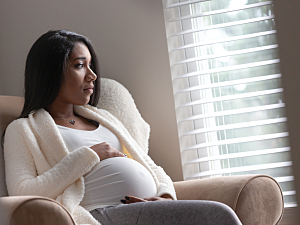Many women enter pregnancy with a pre-existing diagnosis of anxiety. Pregnancy itself can prompt worry about the health of the fetus and newborn, one’s health and the experience of childbirth. The unknowns and uncertainties of the COVID-19 pandemic presented an additional acute stressor to pregnant and postpartum women.
Researchers at Brigham and Women’s Hospital investigated whether pre-existing anxiety exacerbated COVID-19–related health concerns among women who entered perinatal status early in the pandemic. To their surprise, they found the opposite: levels of COVID-19–related worry were greater among women without a pre-existing diagnosis of anxiety.
Cindy H. Liu, PhD, a clinical psychologist who directs the Developmental Risk and Cultural Resilience Laboratory within the Departments of Pediatric Newborn Medicine and Psychiatry, Leena Mittal, MD, a psychiatrist and chief of Women’s Mental Health Services, and colleagues discuss this finding in Psychiatry Research.
Methods
The PEACE Study began at the Brigham in May 2020 to follow the health and well-being of U.S. pregnant and postpartum women during the COVID-19 pandemic. The current analysis included 1,587 women with data collected between May 21, 2020, and June 24, 2021.
As part of an online survey, participants were asked to indicate any previous diagnoses of generalized anxiety disorder by a mental health professional. They completed the Generalized Anxiety Disorder scale (GAD-7, total possible score of 21). Women with a score ≥10 were considered to have clinically significant anxiety.
Participants also rated four items from the Coronavirus Health Impact Survey to indicate how worried they were about contracting the virus, their friends and family becoming infected, and their physical and mental health being harmed.
Participant Characteristics
The mean age of the cohort was 33 years. 56% of participants were pregnant at the time of the survey, and 45% of all participants were primiparas.
18% reported high levels of COVID-19–related health worry, and 25% scored above the clinical cutoff for generalized anxiety. 25% reported having received a diagnosis of GAD before the pregnancy.
Likelihood of GAD Based on COVID-19–related Worry
The two key observations from adjusted analyses were:
- Women who reported high levels of COVID-19–related health worry and had a pre-existing GAD diagnosis were 3.56 times more likely than those with low levels of worry to score in the range of clinically significant generalized anxiety (P<0.001), but those without a pre-existing GAD diagnosis were 6.51 times more likely (P<0.001)
- Participants with a pre-existing GAD diagnosis were 3.01 times more likely than those without a diagnosis to have clinically significant generalized anxiety (P<0.001)
Potential Explanations
The researchers present several possible interpretations of the surprising data:
- Women with a pre-existing GAD diagnosis may have had experience managing their anxiety before the pandemic, while individuals experiencing anxiety for the first time may have been less equipped to cope (and confronted by long waitlists for mental healthcare)
- Individuals with pre-existing anxiety may have experienced fewer symptoms of anxiety during “lockdowns” if they felt a greater sense of safety
- Women who were previously able to self-manage their anxious tendencies without pursuing treatment may have found themselves unable to cope as well when they lost family contact, social support, and community support groups
- Some women with “no preexisting GAD” may have met GAD criteria previously if they’d been assessed, notably women with subtypes of anxiety such as a more somatic experience of worry, preoccupation with health concerns, or high trait anxiety with subclinical symptoms
- Among chronically anxious individuals, there may be a “ceiling effect” of reported symptoms in response to a new source of stress
Clinical Implications
The authors also discuss the important clinical implications of their findings:
- Treatment for anxiety may have had a robust prophylactic effect over time—an exciting possibility for the field of psychiatry—so the group with prior GAD should be analyzed to determine whether certain medications or therapies conferred resilience against future anxiety-producing experiences
- If differences in interpreting anxiety sensations are found to explain differences in the severity of anxiety symptoms, a meaningful intervention would be psychoeducation to normalize the experience of anxiety for women with high COVID-19–related worry
- Since it appears some patients with anxiety weren’t able to obtain a previous diagnosis of GAD, it’s important to continue to delineate subtypes of anxiety and identify optimal diagnostic approaches and treatments for each
